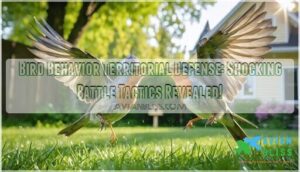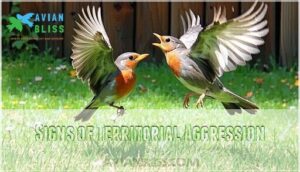This site is supported by our readers. We may earn a commission, at no cost to you, if you purchase through links.

This bird behavior territorial defense isn’t just about being feathered bullies—it’s essential for survival.
When a robin puffs its chest or a hummingbird dives at intruders, they’re protecting nesting sites, food sources, and potential mates.
You can observe this territorial ballet in your own backyard, especially during breeding season when the stakes are highest.
Each species has unique defense tactics, from the melodious warnings of songbirds to the silent, threatening postures of larger raptors.
The secret language behind these territorial displays reveals fascinating evolutionary strategies.
Table Of Contents
- Key Takeaways
- Defending Home Turf
- Territoriality Benefits
- Factors Influencing Territory Size
- Territorial Defense Strategies
- Interspecific Territoriality
- Territorial Marking and Maintenance
- Territorial Aggression in Birds
- Impact of Urbanization on Territories
- Territorial Behavior in Different Environments
- Evolutionary Advantages of Territoriality
- Frequently Asked Questions (FAQs)
- What is territorial defense in birds?
- What is a bird’s territorial behavior?
- How do birds express territoriality?
- How do birds defend their territory?
- What is territorial behavior?
- How does territoriality benefit birds?
- How to stop birds from being territorial?
- What behavior an animal might use to defend its territory?
- What do birds do to defend themselves?
- What does it mean if a bird defends a ‘territory’?
- Conclusion
Key Takeaways
- You’ll see birds defending territories to secure essential resources like food, nesting sites, and potential mates – it’s not just aggression but a critical survival strategy.
- You’ll notice different birds use unique defense tactics including songs, visual displays, and physical confrontations that intensify during breeding season when competition is highest.
- You’ll find territory size varies based on diet, resource availability, and seasonal changes – carnivorous birds need larger territories while territories shrink when resources are abundant.
- You’ll observe that urbanization has forced birds to adapt their territorial behaviors, creating smaller territories and altered defense strategies as they compete for increasingly limited resources.
Defending Home Turf
You’ll witness birds fighting fiercely for their territories, using everything from elaborate songs to physical confrontations when rivals threaten their breeding grounds and food sources.
Just like you’d protect your home from unwanted visitors, these feathered defenders employ strategic vocalizations, intimidating displays, and sometimes aggressive chases to maintain exclusive control over their precious resources, utilizing elaborate songs and physical confrontations.
Why Birds Defend Territories
Birds frequently defend territories as a fundamental survival strategy, not just showing off their feathers.
This territorial defense serves as nature’s way of ensuring breeding success and resource monopolization.
Why birds fiercely guard their space:
- Securing essential food resources that sustain them and their offspring
- Protecting premium nesting sites essential for raising vulnerable young
- Attracting quality mates through demonstration of territorial prowess
- Establishing safe zones free from competitors and predators
This bird territoriality isn’t just about being bossy—it’s a calculated survival advantage that helps maintain population control through strategic resource defense.
Types of Territories and Functions
Now that you understand why birds stake their claims, let’s explore the five main territory types they establish.
You’ll observe all-purpose territories where birds conduct every activity from breeding to feeding. Some create specialized mating territories for courtship, nesting territories for raising young, or non-breeding territories for off-season feeding.
Group territories, like those of Acorn Woodpeckers, demonstrate collective resource defense through territorial displays—proof that mate guarding and survival drive these fascinating defense systems.
These displays often include vocalizations like songs to mark territory.
Territorial Behavior in Different Species
Species variations in territorial behaviors tell fascinating tales.
Red-winged Blackbirds fiercely guard wetlands, while Northern Cardinals defend backyard zones no matter the season.
Hummingbirds? They’re like little warriors, zipping between flower patches to secure food sources.
Colonial seabirds, though packed on cliffs, fiercely protect their personal bubble.
Avian aggression shows clever strategies to keep territories safe.
Here’s how territorial defense differs among species:
- Cardinals: Year-round yard defenders.
- Penguins: Protect nests and prized pebbles.
- Hummingbirds: Guard nectar spots with speed-induced flair.
- Seabirds: Cling to cliffs with strict no-entry zones.
Territoriality Benefits
When birds defend their territories, they’re not just being aggressive—they’re securing essential resources like food, nesting sites, and shelter.
By keeping others out, they also reduce the risk of diseases and predators spreading within their home turf.
Resource Access and Protection
In terms of resource access and protection, territorial defense is how birds guarantee food security and claim nesting sites.
By monopolizing the best locations, they reduce resource competition and guarantee territory quality necessary for breeding success.
During this time, it’s like they’re saying, “This is my turf—hands off!”
This behavior minimizes nest site competition, giving their young the best chance to thrive.
Reduced Disease Transmission and Predation
Territorial defense isn’t just about grabbing the best nest—it’s a smart way to dodge trouble.
By keeping competitors out, birds minimize disease transmission and predator pressure, creating healthier offspring and stronger populations.
It’s nature’s ultimate health plan, doubling as a predator avoidance strategy, think of it as the bird world’s version of wearing a mask and locking the door—an evolutionary advantage that guarantees survival while boosting population resilience with a smart way to ensure survival.
Spacing Individuals Apart
Bird territoriality works like nature’s spacing tool, keeping birds from stepping on each other’s feathers.
By defending territorial boundaries, they promote Population Regulation and Resource Partitioning, minimizing intraspecific competition.
This creates clearer Social Hierarchies and improves Habitat Quality.
With proper dispersal patterns, birds avoid overcrowding, ensuring their resources aren’t stretched too thin.
In short, territorial defense might just be the perfect room-sharing strategy to keep everyone thriving harmoniously.
Factors Influencing Territory Size
You’ve probably noticed that some birds fiercely guard large areas, while others stick to smaller patches.
Territory size depends on what they eat, how crowded their neighborhood is, and even the time of year.
Population Density and Resource Availability
When birds share a habitat, density dependence kicks in, shrinking territory size as population density rises.
It’s like neighbors crowding a cul-de-sac—space tightens, and boundaries shift to fit everyone.
But it’s not just numbers; resource availability matters too.
In lush environments, birds thrive on smaller patches, but in resource-scarce conditions, they must roam wider to find food resources and nesting spots.
Higher intraspecific competition over limited resources brings intense competition, forcing some to settle for less-than-ideal spaces—a stark reminder of nature’s balancing act.
Diet and Territory Size
In regards to dietary needs, a bird’s territory size often hinges on its menu.
Carnivore territories are vast since hunting demands space, while plant-eaters settle for cozier spots.
Abundant food simplifies life—smaller territories mean less squabbling.
But as resources thin out, expect dramatic territorial defense as birds battle to monopolize what’s left.
This bird behavior makes certain they’ve got the resource access needed for survival.
Seasonal Changes and Territory Adjustments
Nature’s rhythm calls the shots on bird territories.
Seasonal changes mean constant shifts:
- Breeding season shrinks spaces for nest-focused territorial defense.
- Winter territories stretch wider to combat resource fluctuations, keeping bellies full.
- Migration’s impact sees shared or abandoned zones as birds chase better climates.
These shifts are influenced by hormonal changes in birds.
It’s like birds wield maps, adjusting boundaries with precision and purpose to survive.
Territorial Defense Strategies
When birds protect their territory, they don’t just rely on gentle warnings—they get loud, flashy, and even confrontational.
You’ll see them singing, posturing, chasing, and sometimes brawling to defend what’s theirs.
Aggressive Behavior and Warning Calls
Hear those sharp, urgent calls echoing through your yard? That’s not just chatter—it’s a bold display of aggressive behavior and bird communication!
Warning calls, from subtle chirps to piercing screeches, act as threat signals, telling rivals, “This space is taken!” and alerting allies to danger. These vocalization types are customized for each species, serving as personalized alarms.
Birds often combine these with intimidation tactics like chasing, diving, or even brief physical confrontations, proving their territorial roots run deep. To further establish dominance, some species even engage in ritualized agonistic behaviors.
Their “get lost” message? Loud and clear!
Visual Displays and Threat Postures
You spot the magic of visual displays in territorial defense: birds showing off like nature’s performers.
They communicate authority with plumage coloration and dramatic gestures.
- Wing-spreading makes them look bigger.
- Feather fluffing signals boldness.
- Head bobbing adds flair to their moves.
- Intimidation flights scream, “Back off!”
It’s bird behavior at its most theatrical—control through clear statements!
Chasing and Fighting
When things get heated, territorial defense can escalate into aerial pursuits or ground chases.
Birds like robins and mockingbirds chase rivals with impressive speed and precision.
Physical confrontations, though rare, include pecking or grappling, risking injury but proving their grit.
In some species, cooperative defense adds strength in numbers.
These acts of bird aggression keep intruders away, ensuring resource protection and survival.
Interspecific Territoriality
You’ve probably seen birds chasing off others that don’t look anything like them—that’s interspecific territoriality in action.
It happens when birds defend their space not just from their own kind, but from entirely different species, often over food, nests, or prime real estate.
Definition and Examples
In the bird world, avian territoriality often sparks interspecies drama, showcasing bold defenses.
Birds don’t just safeguard resources from their kind; they face off with other species too.
You’ll spot hummingbirds fiercely guarding feeders, sparrows battling over nesting sites, and meadowlarks defending rich feeding grounds.
- Hummingbirds: Aggressively claim nectar-filled feeders.
- Sparrows: Fight for limited nesting spots.
- Meadowlarks: Stake territories over resource-rich fields.
Adaptive IT Hypothesis and Mistaken Identity
Sometimes, bird territoriality isn’t just a turf war—it’s a classic case of mistaken identity.
The Adaptive IT Hypothesis highlights how birds’ cognitive limits lead to recognition errors, triggering territorial defense against perceived rivals.
When resource overlap occurs, some species rely on acoustic mimicry, copying bird songs to outwit competitors.
This adaptive strategy helps avoid direct conflict but can escalate bird aggression.
A clever tactic? Sure, but it teaches us how bird behavior balances cognitive quirks with survival instincts, influencing territoriality and coexistence.
Cost of Defense and Territorial Behavior
Imagine this scenario: defending territory is a high-stakes game of energy and risk.
Birds must weigh defense tradeoffs—fight or retreat? It’s all about balancing resource value against opportunity costs.
Here’s how territoriality plays out:
- Energy Expenditure: Every chase burns calories.
- Risk Assessment: Aggression risks injury, even death.
- Hormone Regulation: Testosterone fuels bird aggression, but overstimulation reduces survival odds.
Nature’s a strategist, not a gambler!
Territorial Marking and Maintenance
You’ve probably noticed how birds seem to take their property lines seriously, and they don’t just wing it regarding keeping their space.
Through singing, patrolling, and even scent marking, they craft clear boundaries, ensuring rivals know exactly where they stand, using methods like singing to communicate.
Singing and Vocal Displays
When a bird sings, it’s not just a cheerful melody; it’s laying down the law.
Territorial songs, packed with acoustic signals, announce ownership loud and clear.
Song complexity impresses mates and warns rivals.
Some species master vocal mimicry, adopting bird calls to outshine competitors.
Others use duet singing, performing vocal displays with partners to solidify bonds.
Each note is a powerful tool of persuasion, turning serene warbling into strategic territory defense.
Visual Markings and Scent Marking
Birds use clever cues to defend their space. You’ll notice acts like plumage signaling or extreme color intimidation to stand out.
Sometimes, they rely on scent communication to create invisible markers. Consider using visual deterrent products for effective bird control.
Look at these tactics:
- Flash vibrant feathers for species recognition.
- Use scent for marking boundaries.
- Combine threat displays with movement.
- Create ephemeral art via unique visual displays.
Patroling and Boundary Defense
While visual signals announce ownership, it’s what birds do next that truly matters.
Regular boundary patrols serve as walking "keep out" signs, with males typically conducting perimeter checks at specific times daily.
You’ll notice patrol frequency increases during breeding season when territory size matters most.
Some species employ cooperative defense, with pairs tag-teaming to protect their domain.
These systematic boundary patrols enhance intruder detection through practiced territorial displays, creating an efficient early warning system.
When an unwelcome visitor appears, the resident bird doesn’t just warn—it leaps into action, using territorial displays to defend its territory, which is a key part of its domain.
Territorial Aggression in Birds
You’ll witness birds transform into feathered fighters when their territory is threatened, using an impressive arsenal of defensive tactics from aggressive calls to physical combat.
These territorial showdowns aren’t just dramatic displays—they’re critical survival strategies that help birds secure essential resources for breeding success and offspring survival, which is key to their breeding success.
Causes and Triggers of Aggression
After establishing territory boundaries through marking, birds must remain vigilant against challengers.
What ignites territorial aggression in your backyard birds?
Resource scarcity often triggers fierce territorial disputes when food or nesting materials become limited.
Hormonal influences peak during breeding season, intensifying mate guarding behaviors.
You’ll notice competition intensity increases with intruder proximity—the closer they get, the more aggressively they’re confronted.
Bird dominance hierarchies also play a role, with established pairs showing greater defensive responses when their status is threatened.
Even environmental changes can spark unexpected bird behavior changes, and resource scarcity is a key factor in this context.
Birds will fiercely defend their territory, especially during breeding season, to protect their resources and mates.
Signs of Territorial Aggression
When a feathered defender feels threatened, you’ll notice clear signs of territorial aggression in their behavior.
Look for dramatic posture displays like puffed-up feathers, erect crests, and wing-spreading. Vocalization types range from warning calls to aggressive songs that increase in volume and frequency.
Birds often exhibit distinctive flight patterns, including dive-bombing and aerial chases. Physical attacks may involve pecking, striking with wings, or even talon grappling.
Plumage changes sometimes occur as birds display their brightest colors to intimidate rivals. Understanding this bird body language helps identify when a territory dispute is underway, and recognizing these signs can be crucial for conflict resolution.
Managing and Reducing Territorial Aggression
When confronted with territorial aggression, how can you restore peace?
Try moving your bird’s cage to neutral locations during training.
Reduce territorial stress by teaching behaviors incompatible with aggression, such as "step up" commands.
Create bird-friendly spaces with chewing toys and mineral blocks to redirect energy.
Birds can benefit greatly from enrichment and chewing to reduce boredom.
For persistent issues, use visual or auditory deterrents.
Remember, conflict resolution requires patience—always remain calm and use positive reinforcement for bird aggression management success.
Impact of Urbanization on Territories
You’ll notice how your neighborhood birds have dramatically shrunk their territories as buildings replace their natural habitats, forcing them to adapt with modified defense tactics.
These urban avian residents now compete fiercely for fewer nesting sites and food sources, often using surprising strategies like dawn singing to overcome city noise.
They establish micro-territories in small green spaces you might walk past every day.
Habitat Fragmentation and Nest Competition
The squeeze of habitat fragmentation forces birds into increasingly desperate territorial battles.
As natural spaces shrink, you’ll notice:
- Intensified nest competition in fragmented landscapes, reducing overall nesting success by up to 40% in some species
- Resource scarcity triggering more aggressive territorial defense behaviors
- Species displacement occurring as dominant birds claim limited premium nesting sites
Conservation strategies like habitat corridors and nest box programs help mitigate these pressures, supporting sustainable bird populations despite urbanization challenges.
Altered Territorial Behaviors
Birds’ territorial behaviors undergo dramatic shifts in urban environments.
You’ll notice increased aggression as habitat loss forces them into smaller spaces, creating turf wars over limited resources.
Climate change and invasive species compound these stressors, while noise pollution masks their warning calls.
Some species adapt by becoming bolder around humans, while others abandon traditional defense tactics altogether.
Human disturbances disrupt courtship displays and nesting patterns, fundamentally altering how birds establish and defend their territories in our changing world, driven by factors including habitat loss.
Conservation Efforts and Mitigation Strategies
As urban sprawl transforms natural habitats, thoughtful conservation efforts become our best defense for territorial birds.
When you notice warning signs like changed postures or vocalizations, give these feathered defenders space.
To protect bird territories effectively:
- Create wildlife corridors connecting fragmented habitats
- Establish protected areas that limit human disturbances during breeding season
- Support habitat restoration projects that reintroduce native vegetation
These strategies help birds maintain territories where benefits outweigh the costs of defense. Supporting wildlife corridor products can further aid these efforts to preserve natural habitats and support territorial birds.
Territorial Behavior in Different Environments
You’ll notice that birds change their territorial tactics depending on whether they’re defending nests in dense forests, open wetlands, or urban environments.
From the fierce aerial displays of cliff-nesting seabirds to the subtle boundary patrols of woodland songbirds, these environmental adaptations showcase nature’s ingenious solutions to the universal challenge of resource protection.
Terrestrial, Aquatic, and Aerial Environments
As cities expand, birds adapt their territorial behaviors to match their surroundings.
You’ll notice distinct territorial defense patterns across environments. In terrestrial habitats, ground-nesters establish clear boundaries around feeding sites.
Aquatic species use intricate water-based displays, while aerial defenders perform complex flight patterns to protect airspace.
Each habitat influences how birds partition resources and create niche differentiation. These environmental adaptations showcase remarkable habitat specificity, with territorial boundaries shaped by biome influence and available resources.
Some species even use vocal and visual displays to defend their space, demonstrating remarkable adaptability and territorial behaviors in response to their environment.
Adaptations to Different Environmental Conditions
While songbirds claim territories through aerial displays, their environmental surroundings dramatically influence their territorial adaptations.
You’ll notice birds adjust their defense strategies based on climate conditions and habitat variability.
Resource scarcity in deserts forces birds to maintain larger territories, while those in resource-rich areas defend smaller patches.
When altitudinal gradients change, territorial boundaries shift accordingly.
During migration patterns, many species temporarily abandon territorial behavior altogether, conserving energy for their journeys instead of wasteful confrontations.
Territoriality in Extreme Environments
While landscapes shift to extreme conditions, bird territorial behavior adapts accordingly.
In harsh environments like the Arctic and high-altitude territories, you’ll notice remarkable territorial adaptations:
- Desert territoriality intensifies as birds defend scarce water sources with heightened aggression
- Island competition creates unique defense strategies due to limited resources
- Cave nesting species develop specialized acoustic displays that carry in enclosed spaces
You’ll find that territorial disputes in extreme environments aren’t just about space—they’re survival mechanisms that balance energy conservation with resource protection, particularly as climate change impacts traditional territories.
Evolutionary Advantages of Territoriality
You’ll find that birds defend territories for good reason—this behavior increases their chances of survival by securing essential resources and attracting quality mates.
When a bird stakes its claim to an area, it’s not just being territorial for show, but actively boosting its reproductive success and reducing its exposure to predators and diseases.
Resource Competition and Mate Attraction
Moving from diverse environments to the heart of territorial behavior, bird territories revolve around one simple truth: resources mean survival.
When birds fight for territories, they’re battling for food security in an environment of Resource Scarcity. A bird with access to abundant resources isn’t just well-fed—it’s an attractive mate.
You’ll notice that territorial defense intensifies during breeding season when Competition Intensity peaks. Males with prime territories demonstrate higher Breeding Success rates, as females select partners based on Territory Quality rather than looks alone.
Some species even practice Territory Inheritance, where offspring benefit from established boundaries. This resource competition creates a direct pathway to mate attraction, ultimately driving evolutionary advantages through successful reproduction.
Predator Avoidance and Reduced Disease Transmission
Beyond mere territorial squabbles, birds maintain boundaries for essential survival advantages. You’ll notice how territory defense serves as nature’s version of "social distancing," substantially reducing disease transmission among populations.
When birds space themselves apart, they create natural barriers against pathogens that might otherwise spread rapidly through crowded communities. This strategic spacing also enhances predator vigilance and minimizes predation risk.
With fewer neighbors, birds can:
- Detect threats earlier with less visual obstruction
- Maintain cleanliness behavior without contamination from others
- Optimize territory size based on predator presence
- Coordinate defense strategies against common threats
- Establish predictable escape routes within familiar boundaries
Even seemingly aggressive territorial disputes represent sophisticated disease avoidance mechanisms that have evolved over millennia, protecting birds from both microscopic threats and visible predators.
Increased Fitness and Survival Rates
A bird’s territorial success directly translates to increased fitness and survival rates.
When you observe territorial defense in action, you’re witnessing evolution’s strategy for breeding success and offspring quality.
By monopolizing essential resources, birds experience reduced stress and maintain better health.
This resource defense guarantees they’ll have everything needed when raising young.
The strongest defenders typically enjoy higher genetic diversity in their offspring, perpetuating their territorial advantages for generations and ensuring they have the best chance at successful breeding and increased survival rates.
Frequently Asked Questions (FAQs)
What is territorial defense in birds?
Ah, you thought your backyard was yours?
Think again! Birds defend specific areas within their home range to secure resources for breeding and raising young.
You’ll see them using songs, displays, and chasing intruders away, which can be considered a form of defend to secure their territory.
What is a bird’s territorial behavior?
Territorial birds defend specific areas to secure resources like nesting sites and food. You’ll notice them singing, displaying, and chasing intruders to establish boundaries and protect their space from rivals.
How do birds express territoriality?
Ever wondered how our feathered friends stake their claim?
You’ll see birds expressing territoriality through songs and calls, visual displays like puffed feathers, direct chasing of intruders, and sometimes physical confrontations to defend their space.
How do birds defend their territory?
You’ll notice birds defend territories through songs, calls, and displays.
They’ll chase intruders, engage in physical confrontations when necessary, and patrol boundaries regularly—all to protect their breeding, feeding, and nesting resources, which is crucial for their survival and involves physical confrontations.
What is territorial behavior?
You’ll recognize territorial behavior when animals defend specific areas against rivals.
It’s how creatures secure essential resources like food, nesting sites, and mates, ensuring their survival and reproductive success through active protection, which is key to their reproductive success.
How does territoriality benefit birds?
You’ll find that birds gain several advantages from territorial behavior.
It secures essential resources like food and nesting sites, protects mates and offspring from predators, and enhances breeding success by reducing competition.
How to stop birds from being territorial?
To stop territorial birds, remove attractants, install visual deterrents like shiny objects, play predator sounds, block reflective surfaces, and modify your landscape.
You’ll need patience—birds are instinctively defending resources they consider essential.
What behavior an animal might use to defend its territory?
Like sentinels standing guard, animals defend territories through vocalizations, visual displays, scent marking, physical confrontations, and boundary patrols.
You’ll see them use these tactics to protect resources, mates, and offspring from competitors, which involves physical confrontations.
What do birds do to defend themselves?
Birds defend themselves through vocalizations like songs and calls, visual displays such as wing spreading, physical confrontations including pecking and scratching, and territorial chasing.
They’ll also use cooperative defense when working together against intruders, which can be an effective strategy alongside other forms of defense like vocalizations.
What does it mean if a bird defends a ‘territory’?
When a bird defends a territory, it’s protecting a specific area from rivals to secure resources for breeding, nesting, or feeding.
You’ll notice behaviors like singing, displaying, and even physical confrontations with intruders.
Conclusion
Amazingly, over 75% of songbird species display some form of territorial defense, showcasing nature’s competitive spirit.
As you’ve discovered, bird behavior territorial defense involves complex strategies evolved over millennia—from melodious warnings to dramatic aerial displays.
You’ll never view backyard bird interactions the same way again. By understanding these defensive tactics, you’re witnessing evolutionary biology in action.
Next time you hear that persistent robin or witness a hummingbird standoff, remember you’re observing sophisticated bird behavior territorial defense that guarantees their survival.

















